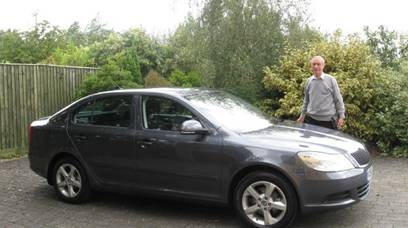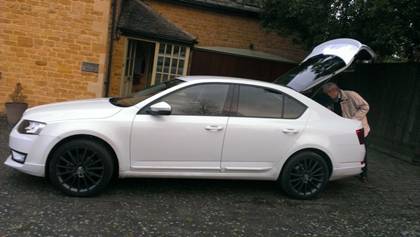Cars
|
|||
|
Never having had a job involving much driving, all our cars have been bought for purely private purposes and on a budget. Maybe one day our lottery numbers will come up, and that elegant Mercedes will appear in the drive. Meanwhile, I’ve listed for the record our family cars. It was a sign of the times: we had our first car at almost exactly the same time as our first television. Like most people, we lived happily without both until then. Now they loom large in most people’s lives. |
|||
|
This was our first car
at home in By the time we got it, it
was working on no more than two cylinders, I swear, and when we took it to
Devon on holiday, I had to get out and push up the steepest hills. Really. Both Mum and Pop learnt
to drive in it, and so did I, though I took my test after Pop had changed it for
a new Wolseley. |
|
||
|
The Wolseley 1500 was,
unusually at the time, a small but relatively powerful car, being built on a
Morris Minor chassis with a 1.5 litre engine.
It had a high top gear, which allowed it to cruise easily at approaching
its top speed, about 75 mph, but the handling was poor on twisty country
roads. I passed my test in
this car, and drove it regularly thereafter. |
|
||
|
|
The first car I owned
was an old 1936 |
||
|
I had no car at
university, but was allowed to drive the family car during vacations: Pop changed the original Wolseley for a new
one after a few years, but, as is the way with these things, we never liked
the replacement quite as much. |
|||
|
|
After I started work, I
longed for a car again. For my budget
of £200, this is what I got – the very basic Ford Popular, only three years
old. It was no more sophisticated than
the pre-war Austin above – cable brakes, no heater, no direction indicators,
vacuum operated wipers etc. The engine
was also very worn: I used to stop
every hour to check the oil and top up as necessary (it usually was). |
||
|
During the severe
winter of 1962-63, I managed to return to |
|||
|
This second-hand Morris
Minor 1000 was a welcome upgrade, with a decent engine to go with the
excellent Minor chassis. It drove
well, though a little noisy from a worn gear-box and the ‘town and country’ tyres
fitted at the rear. |
|
||
|
My first new car, a
1966 Pop changed his
Wolseley 1500 for a Triumph 1300 at about this time, but I have no memory of
driving this car at all. |
|
||
|
|
In 1972, Japanese manufacturers
were just starting to make an impression on the I settled for the
Datsun, and had many years of good service from the little car. |
||
|
On the strength of my
satisfaction with the Datsun, Pop followed suit, and bought a Datsun 120Y
Sunny, of the same colour. While this
car offered value and reliability, the Sunny, unlike the front-wheel drive
Cherry, had antiquated engineering, including a solid axle and cart-springs
at the back, which made handling a problem on any but the best of roads. It was, however,
popular with learners, and had quite the smoothest gear-box I have ever
known. |
|
||
|
After we moved to
Darkes Farm, we borrowed the car for the school run for many years. |
|||
|
We replaced the Datsun
Cherry with a second-hand Volvo 340, our first hatchback. It was a two-door model – safe for the
children but awkward when the front seat tilt mechanism broke. Half of Gloucestershire
seemed to own this model in those days – apart, that is, from those that could
afford something better and they all had the larger 700 series. |
|
||
|
|
Pop eventually replaced
his Sunny with another Japanese offering, the Suzuki Swift. This small, light car was immensely quick off
the mark and manoeuvrable in traffic, and I borrowed it regularly for the
school run. Oddly, it must have been
the only Japanese car which didn’t come with a radio fitted as standard. Pop drove it very
little, and, after trading it in, we had a phone call from the eventual
purchaser who just couldn’t believe the minimal mileage was genuine. |
||
|
I had been intrigued by
the Renault Espace when I first read about it, and, when Jay was born a few
years later, and we needed something with more than five seats to take the
whole family, we tried to hire one.
They were not very common but eventually one firm tracked one
down. We were so impressed that later
that year we got one. Of course, they, and
their growing number of imitators, soon became de rigueur for the
school run, replacing all the up-market large Volvos and the assorted
down-market |
|
||
|
Pop never drove it, but
Teresa took him and Mum out two or three times a week, and there was still
bags of room for Juliet and her push-chair in the back, plus all the
shopping. |
|||
|
|
Teresa inherited this
Renault 5 when her step-father died – her mother not being a driver. She drove it virtually into the ground
taking Jay and her friends to their endless round of activities: ballet, swimming, drama, Kumon maths, music
– the list seemed endless. Helen learnt on it too,
and we were glad when she could drive herself to her own gigs when she was at
home. |
||
|
When I retired, we had to
revert to one car, so this was the one to go.
Most of the fittings were beginning to fall off by then, and, though I
tried to clean it up, it had to go for scrap.
We got £15 for it and were lucky to get that. |
|||
|
|
Eventually the Espace
too had to go. Teresa liked the look
of the Rover range. A bit like the
Volvo 340s some 15 years earlier, Rovers seemed to be the cars of choice for
a large number of people in Gloucestershire, and, as the ailing firm were
offering very good deals, we joined them with a Rover 45. |
||
|
|
As remarked earlier, it
is rarely possible to repeat something exactly. We had been very happy with the first
Rover, so replaced it with a second, but with a few extras, such as
air-conditioning (which we wanted), alloy wheels and spoiler (which we
didn’t) and leather seats (which we didn’t particularly want at the time, but
how grateful we were for them when Jay was a horse-owner depositing mud all
over them – they just wiped clean). |
||
|
But it didn’t seem as
solidly built as the earlier one.
Maybe it was the fashionable silver colour, but it seemed like driving
a giant tin-can. And following the demise of Rover we lost most of the
three-year guarantee. |
|||
|
One acquisition was not
a car at all: we had been thinking
about getting an old banger for Jay to learn to drive in, but, as all her
interest was devoted to her four-footed friends rather than the four-wheeled
variety, we decided to provide Clyde with transport instead. Hence the old We sold it after she
had gone to university. |
|
||
|
When Jay’s interest
eventually turned to learning to drive we saw a couple of pale blue Fiat
Seicentos, but initially rejected them.
Then we failed to strike a deal on a different car we selected, and
went back to get Fizzy. Jay was
delighted as she fancied it all along. Small and nippy, it was
ideal for parking in Winchcombe – and it meant no clash of transport between
Roger’s bowls and Jay’s riding. To
date, it still soldiers on with Jay. |
|
||
|
After over eight years
we got around to replacing our faithful Rover, which was starting to look its
age, though it had never let us down.
An updated version would have suited us fine, but of course Rover no
longer existed, and we had not been able to agree on what to get. That changed when Teresa noted a tempting
offer for the Skoda Octavia on the radio, and Roger recalled that this model
came as close as any to the Rover 45 concept.
When we looked for our nearest dealers, we found that one was the Accordingly, we went for a test drive and were suitably
impressed. The model advertised was
selling so well that it needed to be ordered, so we actually ended up with a
similar deal on a car already in the showroom. Unfortunately, the car was destined to be
with us for little more than three years, having been written off after an
accident. Its replacement was
another Skoda Octavia, two years younger, an ex-demonstrator of the so-called
Black Edition: a good looking car with
a lot of extras. But, as I have
remarked before, like for like replacements never seem quite as good as their
predecessor. |
|
||
Home Roger Top |
|||

















